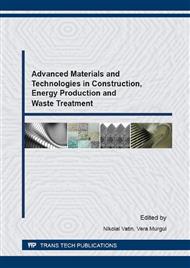[1]
Khozin V.G., Usilenie epoksidnykh polimerov, Kazan: PIK «Dom Pechati», 2004, 446 (In Russian).
Google Scholar
[2]
Bykov E.A., Degtyarev V.V., Sovremennye napolniteli – vazhnyi factor povysheniya konkurentosposobnosti kompositov /Plast. Massy, 2006, №1, pp.32-36 (In Russian).
Google Scholar
[3]
Barakhtenko V.V., Burdonov A.E., Zelinskaya E.V., Tolmacheva N.A., Golovnina A.V., Samorokov V.E., Investigation of modern building materials based industrial waste /Fundamentals, 2013, № 10-12, pp.2599-2603 (In Russian).
Google Scholar
[4]
Rout A.K., Study on mechanical and tribo-performance of rice-husk filled glass–epoxy hybrid composites/ A.K. Rout, A. Satapathy/Materials and Design, 2012, Vol. 41, pp.131-141.
DOI: 10.1016/j.matdes.2012.05.002
Google Scholar
[5]
Kolesnikova I.V., Nikolaeva L.N., Galeev R.R., Polyvinilchloride Compositions with the Use of Organomineral Fillers/Stroitelnye materialy, 2009, №8, pp.43-45 (In Russian).
Google Scholar
[6]
Galeev R.R., Kolesnikova I.V., Abdrahmanova L.A., Ispolzovanie promyshlennykh otkhodov neorganicheskoi prirody v stroitelnyh materialakh na osnove organicheskogo syrya/ Materials of scientific works of the Fourth Resurrection readings Polimery v stroitelstve, Kazan, 2014, pp.19-20.
Google Scholar
[7]
Maisuradze N.V., Abdrakhmanova L.A., Napolnenie ekhpoksidnykh kompozicii dispersnymi organo-neorganicheskimi othodami/Vestnik Kazan State Technological University, 2015, Vol. 18, №18, pp.179-181 (In Russian).
Google Scholar
[7]
Fiore V., Epoxy resins as a matrix material in advanced fiber-reinforced polymer (FRP) composites /Advanced Fibre-Reinforced Polymer (FRP) Composites for Structural Applications/ V. Fiore A. Valenza, Woodhead Publishing Limited, 2013, Part 1, pp.88-121.
DOI: 10.1533/9780857098641.1.88
Google Scholar
[8]
Lapickaya T.V., Lapickii V.A., Epoksidnye materialy/Kompozitnyj mir, 2006, № 7, pp.16-17 (In Russian).
Google Scholar
[9]
Vernigorova V.N., Makridin N.I., Maksimova I.N., Sokolova U.A., Fiziko-himicheskie osnovy stroitelnogo materialovedeniya, Moscow: АСВ, 2003, 136 (In Russian).
Google Scholar
[10]
Garton A., Stevenson W., Wang S.P., The crossking of epoxy resins at interfaces. V. Amine cured resins at carbon and graphite surfaces/J. of Polym. Sci., 1988, Vol. 26A, № 5, pp.1377-1391.
DOI: 10.1002/pola.1988.080260511
Google Scholar
[11]
Apeksimov N.V., Trofimov A.N., Simonov-Emelyanov I.D., Strukturoobrazovanie i processy usadki v napolnennykh ehpoksidianovykh oligomerakh pri otverzhdenii/Plasticheskie massy, 2013, №10, pp.9-13 (In Russian).
Google Scholar
[12]
Skladanyuk R.V., Zakordonskii V.P., Influence of physical networking on the kinetics of the epoxy and amine reaction in filled systems/Macromolecular compounds. Serie A, 2005, Vol. 47. №1, pp.34-43 (In Russian).
Google Scholar


